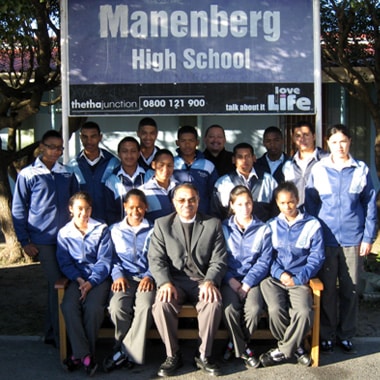
The Legacy of Apartheid and Water Access in South African Schools
By Chyna Brodie, Green 2.0 Winter Fellow
With an upbringing shaped by her parents’ love of travel, finding an opportunity to experience that same worldliness for herself was always a priority for Chyna. While pursuing environmental advocacy, climate justice, and student government in college, Chyna had been looking for a travel opportunity that combined all of these interests. Through her school’s extensive abroad programs, she was able to visit South Africa. In this blog, Chyna speaks on her experience in South Africa and the lasting ramifications of apartheid and the increasingly present issue of water shortage.
Some of my favorite moments of my trip to South Africa were spent at a school located six miles from the Cape Town International Airport, Manenberg High School. The students were so full of life and wanted us to be a part of whatever adventure they created. However, conversations with some of the community members who ran the school, it became clear how the origins of this school were tied to apartheid.
The school’s inception dates back to 1976, when the racist National Party built the school to separate the “coloured population” from the white population. The students who attended this school had been unjustly uprooted from their homes in central Cape Town, particularly from the vibrant District Six, in accordance with the discriminatory Group Areas Act.
The establishment of this school, therefore, holds a significant historical and social significance, as it represents the product of a tumultuous era of segregation and oppression. As one of the residual effects of apartheid, Manenberg continues to be robbed of receiving the amount of resources it deserves, one of them being consistent access to water for its students.
This can be attributed to the “serious shortfalls […] regarding the infrastructure of many public schools,” in South Africa. When Manenberg High School was originally constructed, it was not held to the same design standards of schools built for white students. Instead, schools like Manenberg were built as “plain, simple concrete structures,” leading to the water access, health, and sanitation concerns of today.

When visiting the school, one of the only requests the administrators had was to bring as many gallons of water as possible. The following day, our group brought the water to the school and the difference it made was astounding. I realized that some of the students we met the day before weren’t quiet, they were just dehydrated. No student should have to experience this.
The lingering effects of apartheid have created a reality where Black students and students of color in lower income communities in South Africa do not have access to the water they need. Students cannot thrive without access to basic human rights. If we are to engage in real conversations about equity, this has to be taken seriously. Access to water cannot come from temporary benefactors, but an institutional commitment to change.
To keep in touch with Chyna, follow her on LinkedIn.